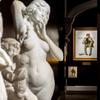Manet & Morisot: A Partnership in Portraits
- September 09, 2020 09:33
The tradition of artists painting fellow artists is a long one, and the finished product can reveal as much about the painter as the sitter. In the case of Edouard Manet and Berthe Morisot, their artistic partnership reveals a mutual understanding, respect and even love between these two great figures of the 19th-century move towards modernism. Manet painted Morisot, his good friend and eventual sister-in-law, a total of twelve times — more than any other model — and kept a number of those paintings in his personal collection until his death.
The artists met at the Louvre in 1868 while 27-year-old Morisot was spending the day copying a Rubens in the museum. She already knew Manet by reputation, of course, and admired him. He had created a sensation at the Salon and Salon des Refusés with his scandalous Olympia and Luncheon on the Grass and was the de facto leader of the Parisian avant-garde. His work had helped transition the art world from Academic Realism to Impressionism in the late 19th century and won him the respect and admiration of young emerging artists like Monet and Renoir. But Morisot had also had work accepted into the Salon by this time, and Manet recognized her talent immediately.
When Manet needed a model for his famous painting, The Balcony (Musée d'Orsay, Paris), he thought of Morisot right away. The opportunity to visit the master's studio, see him at work and view his unfinished sketches must have been tempting, and she accepted. Manet and Morisot became fast friends and trusted colleagues. They formed a strong creative bond and took inspiration from one another's styles and methods. Morisot, having studied under Barbizon master Jean-Baptiste-Camille Corot, persuaded Manet to venture from his studio and work en plein air, significantly impacting his approach to his work. Likewise, Morisot experienced a breakthrough when exposed to Manet's revolutionary new approach to painting. He also helped further her career, recommending her work to buyers and even keeping three of her paintings in his own bedroom.
The duo grew extremely fond of each other and were perhaps even in love, according to some accounts. But Manet was married, and Morisot was careful to avoid any appearance of impropriety. Being his model already came with a certain amount of risk to her reputation, so her mother accompanied her to Manet's studio for her sittings.
Women belonging to the Parisian haute bourgeoisie were expected to dutifully perform the role of wife and mother but allowed few other ambitions. Hobbies like painting were tolerated, but a career in art was frowned upon. Even an unchaperoned trip outdoors could raise eyebrows — a difficult obstacle to navigate for an artist like Morisot who had been trained with a foundation of plein air painting. Double standards for male and female artists abounded.
Despite his avant-garde tendencies and the esteem in which he held her, Manet never portrayed her in the act of painting but only in indoor, domestic settings. One of the last portraits Manet painted of Morisot, Femme Allongée sur un Canapé, an oil on canvas from 1873, pictures her in repose on a sofa. Around this time, he began to paint her in less posed, more fleeting states. Intimate and candid, this work is rendered in hurried, broad brushstrokes that give the work a daring unfinished quality, mirroring the pace of modern life. She is wearing a long dark dress typical of Manet's depictions of her, and she looks away from the viewer — and Manet. Her pensive, sober pose and expression suggest Manet's understanding of her struggle for legitimacy during a period when women were not permitted a professional identity. The artist kept this portrait of Berthe Morisot throughout his life, and it was listed as part of his studio's inventory after his death.
At the time this portrait was painted, Morisot's mother was anxious that she settle into a more conventional lifestyle and marry. Berthe, devoted to her art, had rebuffed several suitors over the years. She was considered quite beautiful with her dark features and came from a well-connected family, but she was a freethinker who had put off marriage for her career. Finally, in 1874, perhaps as a way to remain connected to her friend and mentor, Morisot married Manet's younger brother Eugène who became her manager and promoted his wife's art enthusiastically. While she had never painted Edouard, she painted Eugène several times with their daughter, depicting him as kind, warm and fatherly.
That same year, Morisot was the only female artist to exhibit with the Impressionists at their first show, but Manet declined his invitation to participate. He had advised her to decline as well, but she forged her own path and exhibited with the Impressionists until 1886. Today, Manet's portraits of Morisot are highly celebrated, and the majority reside in museums, including the Musée d'Orsay in Paris and the Metropolitan Museum of Art in New York. They represent an important part of his oeuvre and provide a fascinating window into the intertwined lives of these two icons of Impressionism.
About M.S. Rau:
M.S. Rau has spent more than 100 years earning the trust of discerning collectors worldwide. Located in the heart of New Orleans’ historic French Quarter, our peerless showroom houses one of the world’s most extensive and stunning collections of museum-quality fine art by artists such as Claude Monet and William Bouguereau, 18th- and 19th-century antiques and breathtaking jewelry, including rare colored diamonds.






100x100_n.jpg)

100x100_c.jpg)












